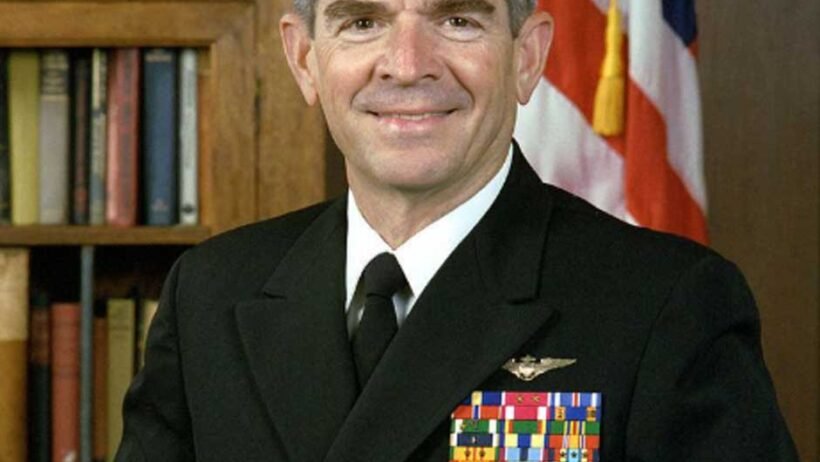Introduction
Admiral Jerome LaMarr Johnson, born on September 21, 1935, stands as a distinguished figure in the annals of the United States Navy. A retired four-star admiral, his career spanned nearly four decades, marked by significant leadership roles and profound contributions to national defense. Johnson’s tenure saw him command critical naval forces and serve in top-tier strategic positions, leaving an indelible mark on the institution he served.
His journey from a Texas A&M graduate to one of the Navy’s highest-ranking officers exemplifies a life dedicated to duty, honor, and country. This article delves into the remarkable career and enduring legacy of Admiral Jerome L. Johnson, a true American patriot.
Early Life and Entry into Naval Service
Jerome L. Johnson’s foundational years were spent in Texas, where he cultivated the discipline and drive that would define his future. He pursued higher education at Texas A&M University, graduating in 1956. This achievement was particularly notable as he would later become the third alumnus from the university to attain the prestigious four-star rank.
Following his graduation, Johnson embarked on his naval career by entering the Naval Aviation Cadet Program. His dedication and aptitude quickly shone through, leading to his commissioning and designation as a Naval Aviator. This marked the beginning of an illustrious career that would see him soar through the ranks and take on increasingly complex responsibilities.
A Distinguished Military Career
Admiral Johnson’s active duty service extended for almost 38 years, a period characterized by a series of high-profile commands and strategic assignments. His leadership at sea included commanding Attack Squadron Twenty-Seven (VA-27), the combat stores ship USS San Jose, and the aircraft carrier USS Coral Sea. These early commands provided him with invaluable operational experience and honed his leadership skills.
His ascent continued with command of Carrier Group 4, followed by the pivotal roles of commanding the United States Second Fleet, Joint Task Force 120, and NATO’s Striking Fleet Atlantic from 1988 to 1990. These positions placed him at the forefront of naval operations, overseeing vast fleets and multinational forces during a critical period in global geopolitics.
Vice Chief of Naval Operations and the “Gray Eagle”
From 1990 to 1992, Admiral Johnson served as the Vice Chief of Naval Operations, the second-highest-ranking officer in the U.S. Navy. In this capacity, he played a crucial role in shaping naval policy, strategy, and resource allocation, contributing significantly to the Navy’s readiness and future direction.
Before his retirement from active service, Johnson earned the esteemed title of the Navy’s “Gray Eagle.” This honorary designation is bestowed upon the longest-serving Naval Aviator on active duty, a testament to his unparalleled dedication and extensive experience in naval aviation. It symbolizes a career marked by continuous service and unwavering commitment to the skies and seas.
Post-Military Contributions
Upon retiring from his distinguished military career, Admiral Johnson continued his commitment to service through various civilian endeavors. For a decade, he served as the President and Chief Executive Officer of the Navy-Marine Corps Relief Society. Under his leadership, this non-profit organization disbursed over $670 million in interest-free loans, grants, and tuition assistance, providing vital support to active-duty and retired sailors, Marines, and their families.
His post-military contributions also extended to leadership roles in other significant organizations. From 2002 to 2004, he chaired the Board of the 385,000-member Military Officers Association of America (MOAA). Additionally, he has served on the Boards of Directors for Smiths Detection Inc. and Smiths Interconnect Inc., as Vice President and Board of Directors for Wärtsilä Defense Inc., and as a Trustee for the National Museum of Naval Aviation.
Personal Life and Enduring Legacy
Admiral Johnson’s personal life has been marked by enduring relationships and a continued connection to his community. He was married to Joy Johnson for 59 years until her passing in 2014, and together they raised three adult children. He currently resides in Fort Myers, Florida, with his second wife, Marsha.
Admiral Jerome L. Johnson’s career is a testament to exceptional leadership, strategic vision, and unwavering dedication. His service as a Naval Aviator, a commander of major fleets, and a top naval strategist, followed by his impactful contributions in the civilian sector, solidify his place as a revered figure. His legacy continues to inspire future generations of military leaders and public servants, embodying the very best of American leadership.








